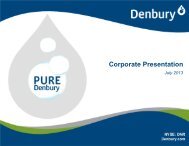Interactive 2009 Annual Report (PDF 7.56 MB) - Denbury Resources ...
Interactive 2009 Annual Report (PDF 7.56 MB) - Denbury Resources ...
Interactive 2009 Annual Report (PDF 7.56 MB) - Denbury Resources ...
- No tags were found...
You also want an ePaper? Increase the reach of your titles
YUMPU automatically turns print PDFs into web optimized ePapers that Google loves.
<strong>Denbury</strong> <strong>Resources</strong> Inc. <strong>2009</strong> <strong>Annual</strong> <strong>Report</strong> 77Leased property meeting certain capital lease criteria is capitalized, and the present value of the related leasepayments is recorded as a liability. Amortization of capitalized leased assets is computed using the straight-line methodover the shorter of the estimated useful life or the initial lease term.Revenue RecognitionRevenue is recognized at the time oil and natural gas is produced and sold. Any amounts due from purchasers of oiland natural gas are included in accrued production receivable.We follow the sales method of accounting for our oil and natural gas revenue, whereby we recognize revenue on alloil or natural gas sold to our purchasers regardless of whether the sales are proportionate to our ownership in theproperty. A receivable or liability is recognized only to the extent that we have an imbalance on a specific propertygreater than the expected remaining proved reserves. As of December 31, <strong>2009</strong> and 2008, our aggregate oil andnatural gas imbalances were not material to our consolidated financial statements.We recognize revenue and expenses of purchased producing properties at the time we assume effective control,commencing from either the closing or purchase agreement date, depending on the underlying terms and agreements.We follow the same methodology in reverse when we sell properties by recognizing revenue and expenses of the soldproperties until either the closing or purchase agreement date, depending on the underlying terms and agreements.Derivative Instruments and Hedging ActivitiesWe utilize oil and natural gas derivative contracts to mitigate our exposure to commodity price risk associated withour future oil and natural gas production. These derivative contracts have historically consisted of options, in the form ofprice floors or collars, and fixed price swaps. We have also used interest rate lock contracts to mitigate our exposure tointerest rate fluctuations related to sale-leaseback financing of certain equipment used at our oilfield facilities. Ourderivative financial instruments are recorded on the balance sheet as either an asset or a liability measured at fair value.We do not apply hedge accounting to our oil and natural gas derivative contracts and accordingly the changes in thefair value of these instruments are recognized in income in the period of change. See Note 10 for further information onour derivative contracts.Financial Instruments with Off-Balance-Sheet Risk and Concentrations of Credit RiskOur financial instruments that are exposed to concentrations of credit risk consist primarily of cash equivalents, tradeand accrued production receivables, and the derivative instruments discussed above. Our cash equivalents representhigh-quality securities placed with various investment-grade institutions. This investment practice limits our exposure toconcentrations of credit risk. Our trade and accrued production receivables are dispersed among various customersand purchasers; therefore, concentrations of credit risk are limited. Also, most of our significant purchasers are largecompanies with excellent credit ratings. If customers are considered a credit risk, letters of credit are the primarysecurity obtained to support lines of credit. We attempt to minimize our credit risk exposure to the counterparties of ouroil and natural gas derivative contracts through formal credit policies, monitoring procedures and diversification. Thereare no margin requirements with the counterparties of our derivative contracts.CO 2 OperationsWe own and produce CO 2 reserves that are used for our own tertiary oil recovery operations, and in addition, we sella portion to Genesis and to other third party industrial users. We record revenue from our sales of CO 2 to third partieswhen it is produced and sold. CO 2 used for our own tertiary oil recovery operations is not recorded as revenue in theConsolidated Statements of Operations. Expenses related to the production of CO 2 are allocated between volumessold to third parties and volumes used for our own use. The expenses related to third party sales are recorded in “CO 2operating expenses” and the expenses related to our own uses are recorded in “Lease operating expenses” in theConsolidated Statements of Operations or are capitalized as oil and gas properties in our Consolidated BalanceSheets, depending on the status of floods that receive the CO 2 (see “Tertiary Injection Costs” on page 76 for furtherdiscussion). We capitalize acquisitions and the costs of exploring and developing CO 2 reserves. The costs capitalizedare depleted or depreciated on the unit-of-production method, based on proved CO 2 reserves as determined byNotes to Consolidated Financial StatementsForm 10-K Part II




